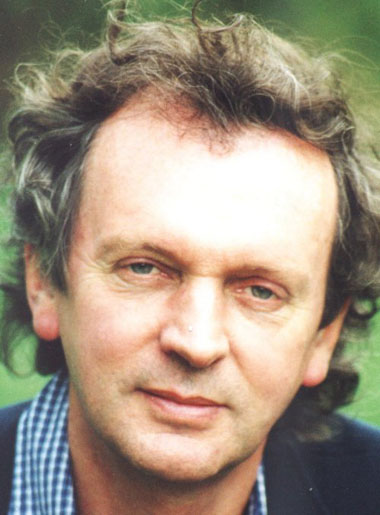The first time I met Robert Seldrick I was in a bookshop in Modena. Spring 2018. I am browsing a book titled Evolutionary mind. Conversations about science, imagination and the soul And there I find all three, comfortably sitting at a table with you to chat or, as they say, to the “trouge”. On the cover are mentioned in this order (presumably alphabetically only): Ralph Abraham, an American mathematician known for his work in dynamical systems theory and one of the pioneers in constructing chaos theory and its applications; Terence McKenna, famous psychedelic expert, author of several books that have become the cornerstone of the subject, as well as ethnobotanist, shamanist, researcher in this field; Robert Sheldrake, an English biologist, is destined to become my only true scientific love for at least the next two years.
I gradually stopped following him compulsively, buying and reading all his articles and scholarly articles firsthand, only since he began to gain some media fame which, though soon forgotten, made me feel less special in being a fan of him. This all happened when one of his TED talks was deemed so dangerous that it was either cleared or “banned”. TED (Technology, Entertainment, and Design) is a series of conferences aimed at spreading ideas of value, since 1984. Subtitle is important: Ideas worth spreading or Ideas worth spreading. I have never liked them, although I have always had to admit their usefulness and effectiveness. What I never liked was the American preaching the participants received, even though they were often notable scholars from the most disparate fields.
An almost empty stage in which the TED letters stand out as a single setting, in red and built to the height of a human. Usually it is the monitor on which any supporting graphic is displayed (photos or videos) connected to the remote control that the same lecturer is dealing with. A few minutes (an average of ten, sometimes 6 minutes from Robert 18), which is also in red on the stopwatch, to say succinctly what has been discovered in the years of life, study, practice, experiments, research, work. They are powerful tools, TEDs, for ease of use on the web, it seems. In person, rather than spend the very long minutes of my life listening to the cadence of someone talking to me, with a friend and captivating speech, the summary of his last book, I would rather read the back cover myself, with the cadence I prefer, being able to form a rough idea of the same things in half a minute .
Thanks to Robert Sheldrake, for example, I have discovered that billions are spent on research, and millions of people work endless hours, only to try and scientifically prove that what is a truism is trivial to me, as a non-scientist. One example above all: endoscopy, or the feeling that each of us has experienced at least once in our lives, from observation. You feel like energy, or an annoyance, behind your neck, and as soon as you turn to check, you suddenly see the other person looking away or, at best, looking at you intently and with a smile to tell you ‘hello,’ I finally realized I was looking at you. Who never did Well, there are laboratories in the world where only accurate experiments are carried out to “scientifically” prove the existence of this phenomenon.
First of all, it must be said that for science only what can be empirically reproduced and replicated anywhere and by anyone with the same results is true and “scientifically proven”. And this is the central problem of all that concerns those uncertainties on the frontiers of science that are mechanically categorized as “Para”: Parascientific, Paraclients, Paranormal. Returning to the observed cognition experiment, for example, it is clear that the results depend on the individual sensitivity and degree of focus, attention, and cognition (and training for cognition) of the human rented guinea pigs. Thus any attempt at verification can rely only on statistical data which are hardly able to confirm the scientific nature of a particular phenomenon. But in fact, the same constants of physical laws, such as the speed of light and the gravitational constant, do not always and everywhere find the same experimental values. Are they then almost facts? By itself, the fact that some facts are unexplainable does not automatically prove that they are not true. But this is what science does with a capital letter: it is documented, it happened, but it cannot be explained, and therefore, it can be archived scientifically as an accident; Opportunity does not invalidate the proven theories.
Robert’s struggle is everywhere: to get science to take into account the uncertainty of his beliefs. In the funny TedTalk in question, in which he appeared barefoot and immersed in a scenography of Christmas trees, he did nothing but succinctly explain the contents of one of his most famous books: science illusions. 10 Doctrines of Modern Science Under Scrutiny (original title science illusionwhich came out in America as Science liberates). Modern science is based on some sentences that are considered inalienable laws. What the author does is show these statements as questions rather than statements, and then prove that the answer is not always, or nearly at all, as certain as it seems. Every scientific theory is, in fact, a theory, and hence it is considered amenable to modification, rewriting, and rethinking of the order of things. This, in fact, happens regularly (eg heliocentric above all), but even here inexplicably one prefers to see these second scientific ideas as exceptions to the iron rule.
Among the tomonae that I read in his hand, many search for seemingly inexplicable, but very frequent, extrasensory phenomena. Events already studied by Carl Gustav Jung and physicist Wolang Pauli and defined by the term synchronization. It is inexplicable to classical science but is real and proven. Fortunately, today quantum physics begins to collapse many beliefs and opens new glimpses (seetangleThe double slit experiment and the observer’s effect on reality). But what’s wrong with trying to ask yourself if there are other answers? Why not try to discuss and discuss only theories that can explain reality by considering all its manifestations and not just the most convenient?
Robert Sheldrake’s theory revolves around the concept of Morphological fields or Morphogenetics (from Greek turns upand shape and originput it in place). In short, his theory is that everything in the universe, including the laws that govern it, develops over time, and it would be more correct to talk about habits rather than laws. Let’s take what his ideas were for Plato too much uranium: two ideas, for the Greek philosopher, exist, ideal, in another ideal place from which we draw, in material reality. For Sheldrake and others, it is more correct to suppose that in the history of the universe, at a given moment, the duality (that is, the idea of two) occurred for the first time, and the more it has been verified. In history, it was easier to repeat. we can imagine Morphological fields Like valleys in time and space: the more these grooves are covered, the wider they are and the greater the probability that a certain event (imagining it as a marble) will occur in them and flow through them. The wider and closer the field is to us, the easier it is for it to resonate.

Robert Sheldrake
This theory, in fact very simple, like all those that later proved to be the most revolutionary, could be able to explain a whole series of mysteries that remain unexplained by modern science. Because there are actually many unresolved questions, although not talked about. Example: Where do the memories lie? Everyone thinks they are intertwined in the brain somewhere, but with all the studies and dissection done so far, there is no physical place where they can be locked up as physical entities. Or how can some animals build very complex structures without communicating with each other? What is consciousness, what are dreams, and how does the mind work? Does existence have a purpose? Or again, how does a cell know what task it has to do? It is a proven fact, for example, that the fetus during pregnancy traces the developmental process of its species (see the appearance of the gills in the development of the fetus). According to Sheldrake’s theory, the embryo’s resonance is proportional to the field formed previously, historically, by similar others before it, and thus we communicate over time.
For the same reason, we faithfully reproduce the ancient rituals of thousands of years: if I put on the clothes, utter the same words and perform the same gestures as those who have preceded me, it is easier for me to interact with the domain already bypassed by those. which he walked before me. But even without it leading to mysticism, or to the idea of a non-local mind, many other examples can be found: in the eyes of polyps, in the flight of pigeons, in the intelligence of plants, or in the crystallization of chemical compounds that occur many times more easily. that thrive in the world. etc etc. The treatise on scientific and philosophical applications, and on the countless examples that have been cited in support of these theories are endless. Being lost in the investigations of this scholar and others are determined to open the mind (The extended mind (is another title of Dr. Sheldrake’s most popular book) not a waste of time. Investigating other possibilities, and striving to continually validate them over time, can only enrich those who decide to stay on the same path. New things are not seen by looking elsewhere, but by looking with new eyes. And who knows that, by beginning to consider the laws of physics to be axiomatic in evolution, and thus amenable to modification, we will not be able to see society and the body of laws written by men for men in a more humane way, without reaching civil disobedience. Perhaps we will move further and further away from the monolithic and immutable world of the past, to arrive at a reality in which we must truly realize how much each of us, at each moment, is to be modified in the future.

“Infuriatingly humble alcohol fanatic. Unapologetic beer practitioner. Analyst.”



